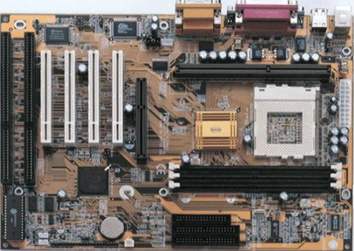ECS P6BXT-A+ Motherboard

As you might notice the P6BXT-A+ is slightly larger than most boards you’ll come across. This is mainly due to the socket 370 placed after the slot to accommodate PPGA Processors. But as we found out this is a mixed blessing. Specially when overclocking it is necessary to used bigger and more effective coolers for the CPU, and a common problem that most Motherboards face is that they simply do not provide enough space for these coolers to be fixed without interfering with the power connector or the Ram Bays. Due to the extra space generated even the biggest of coolers like the VOS32 by global win fits right in to the Motherboard without causing any obstruction, which is good news for overclockers.

The layout apart from that is pretty ordinary; 4 32 bit PCI slots 2 16 bit ISA slots, 3 DIMM slots supporting 3.3V 168 pin Dual Inline Memory Modules. The three modules in unison can handle up to 284 MB of standard SD Ram and 768 MB of registered SDRam.

The P6BXT-A+ also features built on sound based on the Elite CMI 8338 sound chip providing sound blaster 16 compatible sound. This is no Live! But what do you expect from Built in sound? If I may mention the CMI 8338 is just as good as any other build on sound chip!

This board also has an on board hardware monitoring facility using the GLS 520SM hardware monitoring chip. This gives you the flexibility of knowing the CPU Temperature, System Temperature and fan speeds. The board also allows for software control of the FSB, Multiplier (Which is not practical since most CPU’s of today are multiplier locked) and core voltage adjustment.
Overclockability
Well I will have to disappoint folks here. The P6BXT-A+ is certainly not an overclocker’s dream come true, for it has some fundamental problems when it comes to overclocking.
True, the P6BXT’s design allows for a bigger and better heat-sink and cooler to be attached to the CPU, but the catch here is there’re only two power outlets available for Fans. And they are so interestingly placed the only fan connector making sense is the one intended for the CPU. Ideally a Motherboard should have at least 3 fan connectors, one for the inlet, one for the exhaust and one for the CPU fan. Here disappointment
Next comes a feature that all of us overclockers demand; FSB adjustability through the Bios. Well slight problem here as well, true it allows you to change the value through the Bios, but for overclocking, the user must be granted the flexibility of gradually changing the FSB to get an optimum overclocking setting. Unfortunately as I realized when trying to overclock my P II 400MHz CPU, the FSB can be adjusted to 103 then to 112, and then it straight away goes to 133MHz. And to add to that it stops there. Not good at all. When I tried to overclock my CPU to 133 FSB it crashed, while we were successful in doing so with some other boards we have. We have still posted some results we obtained just to demonstrate what could be obtained when over clocking with this board. The results are not bad; they are not very dramatic either. All in all I will not recommend this board to be used for overlocking.